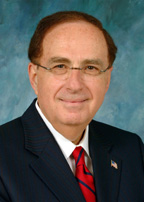Editor’s note: This article is the first in a five-part series that will try to explain the UNMC budget and its relationship to a legislative special session that will take place later this month.
If UNMC’s budget were a Thanksgiving pie, the revenue provided by the state of Nebraska wouldn’t supply even a third of the ingredients.
Yet, there’s no doubt that a severe reduction in state support would change the flavor of the campus. 
“With additional reductions, we will be faced with difficult choices,” UNMC Chancellor Harold M. Maurer, M.D., said. “We hope that legislators will see that the university is vital to the state’s future, and that it serves as a major economic engine.”
Later this month, Nebraska’s one-house Legislature will convene in Lincoln for one purpose: to reduce the state’s budget. The University of Nebraska, whose budget allocation already was reduced twice within the past year, is expected to be a target of further cuts. Those cuts would affect the budget of the 2002-2003 fiscal year, which began July 1. The Legislature will need to deal with a combined $255 million shortfall in the state’s 2001-2003 budget. In addition, more than $500 million will need to be adjusted in the state’s 2003-2004 and 2004-2005 budgets to account for decreases in projected revenues.
Beginning today, UNMC Today will explain UNMC’s budgets, the recent history of funding for the University of Nebraska, possible state government actions during the upcoming special session, and possible results of that session, in order to provide a framework for understanding the impact of budget cuts for UNMC.
It’s important to understand some basics of the UNMC budget, the details of which would take an accountant’s training and a few years of academic health center experience to understand.
The FY 2001-2002 UNMC budget was $328 million; the FY 2002-2003 UNMC budget is $345 million. Only 29 percent of the budget’s revenue is provided by the state’s general fund.
“To say that UNMC is state-funded is a bit of a misrepresentation,” said John Adams, director of budgets and planning at UNMC. “To say we’re state-assisted or state-aided would be a truer statement. However, this state-funding support is absolutely essential to our mission.”
In addition to the state funds, other major revenue sources at UNMC include:
- Cash funds account for about 15 percent of UNMC’s revenue. These funds include items such as student tuition and revenue from clinics at Munroe-Meyer Institute, the UNMC College of Dentistry and some University Medical Associates locations.
Did You Know…
With its revenues, UNMC spends about 36 percent on instruction; 22 percent on research activities; 16 percent on auxiliary/independent operations; 12 percent on public service; and other monies for academic/student support; institutional administration; and physical plant operations.
- Federal grants and contracts account for about 11 percent of the budget revenue.
- Restricted, “trust” funds, which account for about 28 percent of the budget, include non-federal grants and contracts, private gifts, professional fee income, and distributions from the University of Nebraska Foundation and Nebraska Health System.
- Auxiliary and revolving funds total 17 percent of the budget revenue. These funds come from areas such as the print shop, bookstore, parking and biomedical communication.
Of the above revenue categories, the state general fund has grown more slowly, percentage-wise, than the others. That means UNMC’s reliance on state funds is shrinking. Whereas the percentage of state money in UNMC’s budget was over 32 percent two years ago, today it stands at 28.5 percent.
Of the revenue, only the state support and cash funds are non-restricted, meaning UNMC can budget them in areas of the greatest need or highest strategic importance. Commonly, those two funds together are referred to the “state-aided” portion of the budget. The federal grants, trust funds, and auxiliary and revolving funds are earmarked for specific purposes and can’t be shifted to fill pressing needs, Adams said.
“These funds are used to support specific, dedicated activities and are not transferable,” Adams said. “When scientists apply for grants to conduct specific research projects, the university can’t use those funds for other purposes. The same is true for fees for parking or to the Center for Healthy Living.
“When cuts occur in the amount appropriated by the Legislature, the state-aided portion of the budget must absorb all of the cuts.”
Tomorrow: Has the university’s general fund allocation kept pace with the overall state budget?